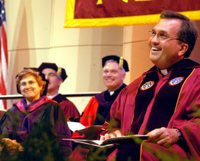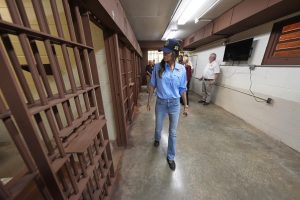Editorial: No matter your opinion of him, Wildes is a true Loyola legend

The Rev. Kevin Wildes, S.J., listens to the encouragement of several speakers at his inauguration in Roussel Hall on Oct. 15, 2004. The inauguration included a Mass, ceremony, reception and Collage concert at the end of the night. Photo credit: The Maroon
August 18, 2017
Regardless of how you feel about our departing president, it is hard to deny that his 14 years here were eventful.
The Rev. Kevin Wildes, S.J., led Loyola through some important years, not only for our univeristy, but also for the city of New Orleans. A little over a year after Wildes became the university’s 16th president, Katrina hit, destroying much of the city and displacing hundreds of thousands of people. Loyola was closed for one semester. It opened back up in January 2006.
Like the rest of the city, Loyola faced financial hardships after the storm. To adapt to those financial woes, Wildes announced “Pathways: Toward Our Second Century,” a major academic restructuring program, which ended many degree programs, including education, computer science and broadcast journalism and reorganized Loyola into five different colleges: business, humanities and natural sciences, law, music and fine arts and social sciences. Following this plan, 2006 brought him his first vote of no confidence.
Many saw the Pathways program as unsuccessful considering the College of Social Sciences was dropped in 2016 with yet another academic reorganization. Some of the majors beneath it became part of what was formerly known as the College of Humanities and Natural Sciences to create the College of Arts and Sciences.
In 2008, Wildes helped shepherd the university through the nation’s worst economic downturn since the 1920s.
In the following years Loyola saw a rise in construction and inconsistent enrollment. Monroe Hall, built in 1969, underwent renovations which were completed in 2015. And the West Road Parking Garage gained two much-needed floors.
Later, in 2016, Wildes again received a vote of no confidence, this time from the University Senate.
Now Wildes is again at the helm of a major university initiative — Project Magis, a program to strengthen the university.
So far, it is enjoying success, with incoming freshmen enrollment up 33 percent this semester. This is the largest incoming first-year class Loyola has seen since 2013. The deficit has also been reduced from $15 million to $6 million.
One of Wildes’ other current projects is Faith in the Future, a capital campaign to raise $100 million to go toward renovations, new scholarship programs and improvements to the university.
No matter how you judge his tenure, there is no doubt that Wildes has truly come to define Loyola and its future.
Just as former president James Carter, who served as president for more than two decades, transformed the campus with the construction of the Communications and Music Complex and the acquisition of the Broadway campus for the law school, Wildes made his mark with the rededication of Monroe Hall and the demolition of the old library — allowing for the new green space now in the middle of campus.
And this just covers the physical transformation of the campus. The legacy of men who were around as long as these cannot simply be measured in terms of the buildings they put up (or take down) — they become a fabric of the university, and shape it for years to come.
When he first came in, Wildes had big shoes to fill. No matter how his tenure is viewed, one thing is for sure — his successor will have a tough time making a mark as big as Wildes, who is truly a Loyola legend.






